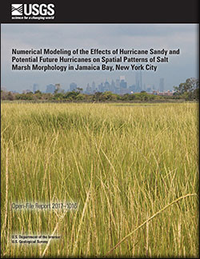Numerical modeling of the effects of Hurricane Sandy and potential future hurricanes on spatial patterns of salt marsh morphology in Jamaica Bay, New York City
Links
- Document: Report (30.5 MB pdf)
- Download citation as: RIS | Dublin Core
Abstract
The salt marshes of Jamaica Bay, managed by the New York City Department of Parks & Recreation and the Gateway National Recreation Area of the National Park Service, serve as a recreational outlet for New York City residents, mitigate flooding, and provide habitat for critical wildlife species. Hurricanes and extra-tropical storms have been recognized as one of the critical drivers of coastal wetland morphology due to their effects on hydrodynamics and sediment transport, deposition, and erosion processes. However, the magnitude and mechanisms of hurricane effects on sediment dynamics and associated coastal wetland morphology in the northeastern United States are poorly understood. In this study, the depth-averaged version of the Delft3D modeling suite, integrated with field measurements, was utilized to examine the effects of Hurricane Sandy and future potential hurricanes on salt marsh morphology in Jamaica Bay, New York City. Hurricane Sandy-induced wind, waves, storm surge, water circulation, sediment transport, deposition, and erosion were simulated by using the modeling system in which vegetation effects on flow resistance, surge reduction, wave attenuation, and sedimentation were also incorporated. Observed marsh elevation change and accretion from a rod surface elevation table and feldspar marker horizons and cesium-137- and lead-210-derived long-term accretion rates were used to calibrate and validate the wind-waves-surge-sediment transport-morphology coupled model.
The model results (storm surge, waves, and marsh deposition and erosion) agreed well with field measurements. The validated modeling system was then used to detect salt marsh morphological change due to Hurricane Sandy across the entire Jamaica Bay over the short-term (for example, 4 days and 1 year) and long-term (for example, 5 and 10 years). Because Hurricanes Sandy (2012) and Irene (2011) were two large and destructive tropical cyclones which hit the northeast coast, the validated coupled model was run to predict the effects of Sandy-like and Irene-like hurricanes with different storm tracks and wind intensities on wetland morphology in Jamaica Bay. Model results indicate that, in Jamaica Bay salt marshes, the morphological changes (greater than 5 millimeters [mm] determined by the long-term marsh accretion rate) caused by Hurricane Sandy were complex and spatially heterogeneous. Most of the erosion (5–40 mm) and deposition (5–30 mm) were mainly characterized by fine sand for channels and bay bottoms and by mud for marsh areas. Hurricane Sandy-generated deposition and erosion were generated locally. The storm-induced net sediment input through Rockaway Inlet was only about 1 percent of the total amount of the sediment reworked by the hurricane. Salt marshes inside the western part of the bay showed erosion overall while marshes inside the eastern part showed deposition from Hurricane Sandy. Model results indicated that most of the marshes could recover from Hurricane Sandy-induced erosion after 1 year and demonstrated continued marsh accretion after the hurricane over the course of long simulation periods although the effect (accretion) was diminished. Local waves and currents generated by Hurricane Sandy appeared to play a critical role in sediment transport and associated wetland morphological change in Jamaica Bay. Hypothetical hurricanes, depending on their track and intensity, cause variable responses in spatial patterns of sediment deposition and erosion compared to simulations without the hurricane. In general, hurricanes passing west of the Jamaica Bay estuary appear to be more destructive to the salt marshes than those passing the east. Consequently, marshes inside the western part of the bay were likely to be more vulnerable to hurricanes than marshes inside the eastern part of the bay.
Suggested Citation
Wang, H., Chen, Q., Hu, K., Snedden, G.A., Hartig, E.K., Couvillion, B.R., Johnson, C.L., and Orton, P.M., 2017, Numerical modeling of the effects of Hurricane Sandy and potential future hurricanes on spatial patterns of salt marsh morphology in Jamaica Bay, New York City: U.S. Geological Survey Open-File Report 2017–1016, 43 p., https://doi.org/10.3133/ofr20171016.
ISSN: 2331-1258 (online)
Study Area
Table of Contents
- Acknowledgments
- Abstract
- Introduction
- Methods
- Results and Discussion
- Conclusions
- References
| Publication type | Report |
|---|---|
| Publication Subtype | USGS Numbered Series |
| Title | Numerical modeling of the effects of Hurricane Sandy and potential future hurricanes on spatial patterns of salt marsh morphology in Jamaica Bay, New York City |
| Series title | Open-File Report |
| Series number | 2017-1016 |
| DOI | 10.3133/ofr20171016 |
| Publication Date | March 29, 2017 |
| Year Published | 2017 |
| Language | English |
| Publisher | U.S. Geological Survey |
| Publisher location | Reston, VA |
| Contributing office(s) | Wetland and Aquatic Research Center |
| Description | vii, 43 p. |
| Country | United States |
| State | New York |
| City | New York City |
| Other Geospatial | Jamaica Bay |
| Online Only (Y/N) | Y |


